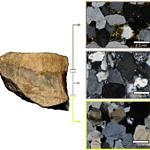From Cantabrian Region to Central Europe: economic territories and procurement and management of quartzites by Palaeolithic societies
A project by Dr. Alejandro Prieto
This recently started project tries to give continuity to the dynamics generated during my PhD research project (Procurement and management of quartzite in the Cantabrian Region: The Middle and Upper Palaeolithic in the Deva, Cares and Güeña Valleys) through three different research lines.
The first one tries to deep into the economy and the way of life created around quartzite by Palaeolithic societies. This line of research is circumscribed to the previous research area. In addition to publish unpublished data from my thesis and present them in different congress, I am going to analyse new lithic assemblages from the Deva, Cares and Güeña valleys, focussing on sites such as Panes II.

The main goal of the second research line is to enlarge the area of study in the Cantabrian Region. To do so, this project will characterise the Sella valley from geological and archaeological perspectives. To do so, I am going to analyse the potential catchment area (massive outcrop, conglomerate outcrops and quaternary deposits) applying the same methodology developed during my PhD research. In this context, the study of new lithic assemblages, could help to understand the economical territories created on this valley, the catchment mechanism of raw material and the distribution and management of different types of quartzites.
The third research line tries to reinforce the methodology already made, exporting the method to other European region with different orography and geological context. Moreover, we will try to understand the economic territories created as consequence of acquisition, management and distribution around this raw material: the quartzites. During my short international stay in Cologne University, I met Dr. Andreas Pastoors, who encourage to analyse the quartzites from the assemblage of Ravensberg-Troisdorf. Partial results, mainly destructive characterisation of the materials, were already presented, offering us interesting but initial results from geologic and archaeological perspectives. The site is dated in the Middle Palaeolithic and it is situated between the cities of Bonn and Cologne, in the lower-middle zone of the Rin Valley. Its functionality is related to the caption and the first stages of transformation of the raw material. These characteristics convert this site as an optimum starting point to understand the economy and way of life create by Palaeolithic societies around quartzite in the Region. In addition, in this area there is a high quantity of other excavated archaeological sites with available lithic collection. We will potentially analyse the other sites such as Inden-Altdorf, Rheindahlen, Kleine Feldhofer Grotte, and Ariendorf. All these sites could help us to understand the distribution and management of quartzite in the area, as the economic territories created around this resource. It is important to mention this part of the project is also supported and aimed by the project: Paleolithic Rhineland
The three different lines converge into a wider perspective of research that tries to understand the differences in catchment, management and distribution of quartzites in different zones and chronologies, but also territorial exploitation. The comparison between the types of quartzites used in the different regions, the diachronic and synchronic differences observed in catchment and management mechanismor the differences in the exploitation of this resource determinedby the types of archaeological site,are the wider and transversal research lines that underwent this project. These topics could help to give a historical perspective to this project.
